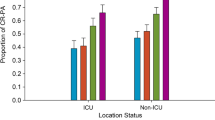Abstract
A cohort study was carried out on hospitalized adult non-critically ill patients (January 2003–December 2004) to identify factors associated with the acquisition of multidrug-resistant Pseudomonas aeruginosa (MDR-PA). A total of 246 non-critically patients were included, 162 (66%) who revealed MDR-PA in the first isolate and 84 (34%) who had carbapenem-resistant P. aeruginosa (CR-PA) isolates. Multivariate analysis identified nosocomial acquisition (odds ratio [OR] 2.7, 95% confidence interval [CI] 1.1–6.3), urinary catheter (OR 2.1, 95%CI 1.1–4.3), and the prior use of fluoroquinolones (OR 2.6, 95%CI 1.0–6.7) as independent risk factors associated with MDR-PA acquisition. Our results show that antibiotics, most notably, fluoroquinolones, may play a major role in the emergence of MDR-PA.
Similar content being viewed by others
References
Livermore DM (2002) Multiple mechanisms of antimicrobial resistance in Pseudomonas aeruginosa: our worst nightmare? Clin Infect Dis 34:634–640. doi:10.1086/338782
Paramythiotou E, Lucet JC, Timsit JF, Vanjak D, Paugam-Burtz C, Trouillet JL et al (2004) Acquisition of multidrug-resistant Pseudomonas aeruginosa in patients in intensive care units: role of antibiotics with antipseudomonal activity. Clin Infect Dis 38:670–677. doi:10.1086/381550
Nseir S, Di Pompeo C, Soubrier S, Delour P, Lenci H, Roussel-Delvallez M et al (2005) First-generation fluoroquinolone use and subsequent emergence of multiple drug-resistant bacteria in the intensive care unit. Crit Care Med 33:283–289. doi:10.1097/01.CCM.0000152230.53473.A1
Falagas ME, Koletsi PK, Kopterides P, Michalopoulos A (2006) Risk factors for isolation of strains susceptible only to polymyxin among patients with Pseudomonas aeruginosa bacteremia. Antimicrob Agents Chemother 50:2541–2543. doi:10.1128/AAC.00224-06
Paterson DL (2006) The epidemiological profile of infections with multidrug-resistant Pseudomonas aeruginosa and Acinetobacter species. Clin Infect Dis 43:S43–S48. doi:10.1086/504476
Falagas ME, Kopterides P (2006) Risk factors for the isolation of multi-drug-resistant Acinetobacter baumannii and Pseudomonas aeruginosa: a systematic review of the literature. J Hosp Infect 64:7–15. doi:10.1016/j.jhin.2006.04.015
Lodise TP, Miller CD, Graves J, Furuno JP, McGregor JC, Lomaestro B et al (2007) Clinical prediction tool to identify patients with Pseudomonas aeruginosa respiratory tract infections at greatest risk for multidrug resistance. Antimicrob Agents Chemother 51:417–422. doi:10.1128/AAC.00851-06
Peña C, Guzmán A, Suarez C, Dominguez MA, Tubau F, Pujol M et al (2007) Effects of carbapenem exposure on the risk for digestive tract carriage of intensive care unit-endemic carbapenem-resistant Pseudomonas aeruginosa strains in critically ill patients. Antimicrob Agents Chemother 51:1967–1971. doi:10.1128/AAC.01483-06
Aubert G, Pozzetto B, Dorche G (1992) Emergence of quinolone-imipenem cross-resistance in Pseudomonas aeruginosa after fluoroquinolone therapy. J Antimicrob Chemother 29:307–312. doi:10.1093/jac/29.3.307
Alyaseen SA, Piper KE, Rouse MS, Steckelberg JM, Patel R (2005) Selection of cross-resistance following exposure of Pseudomonas aeruginosa clinical isolates to ciprofloxacin or cefepime. Antimicrob Agents Chemother 49:2543–2545. doi:10.1128/AAC.49.6.2543-2545.2005
Charlson ME, Pompei P, Ales KL, MacKenzie CR (1987) A new method of classifying prognostic comorbidity in longitudinal studies: development and validation. J Chronic Dis 40:373–383. doi:10.1016/0021-9681(87)90171-8
Friedman ND, Kaye KS, Stout JE, McGarry SA, Trivette SL, Briggs JP et al (2002) Health care-associated bloodstream infections in adults: a reason to change the accepted definition of community-acquired infections. Ann Intern Med 137:791–797
Clinical and Laboratory Standards Institute (formerly NCCLS) (2006) Performance standards for antimicrobial susceptibility testing: 16th informational supplement. CLSI document M100-S16. ISBN 1-56238-588-7. Clinical Laboratory Standards Institute, 940 West Valley Road, Suite 1400, Wayne, Pennsylvania 19087-1898, USA
Falagas ME, Koletsi PK, Bliziotis IA (2006) The diversity of definitions of multidrug-resistant (MDR) and pandrug-resistant (PDR) Acinetobacter baumannii and Pseudomonas aeruginosa. J Med Microbiol 55:1619–1629. doi:10.1099/jmm.0.46747-0
Poole K (2000) Efflux-mediated resistance to fluoroquinolones in gram-negative bacteria. Antimicrob Agents Chemother 44:2233–2241. doi:10.1128/AAC.44.9.2233-2241.2000
Kriengkauykiat J, Porter E, Lomovskaya O, Wong-Beringer A (2005) Use of an efflux pump inhibitor to determine the prevalence of efflux pump-mediated fluoroquinolone resistance and multidrug resistance in Pseudomonas aeruginosa. Antimicrob Agents Chemother 49:565–570. doi:10.1128/AAC.49.2.565-570.2005
Acknowledgments
This work was supported by the National Health Service grant FIS 03/0029 from the Fondo de Investigación Sanitarias and by the Ministerio de Sanidad y Consumo, Instituto de Salud Carlos III - FEDER, Spanish Network for the Research in Infectious Diseases (REIPI C03/14), and Spanish Network for the Research in Infectious Diseases (REIPI RD06/0008).
Author information
Authors and Affiliations
Corresponding author
Rights and permissions
About this article
Cite this article
Peña, C., Suarez, C., Tubau, F. et al. Carbapenem-resistant Pseudomonas aeruginosa: factors influencing multidrug-resistant acquisition in non-critically ill patients. Eur J Clin Microbiol Infect Dis 28, 519–522 (2009). https://doi.org/10.1007/s10096-008-0645-9
Received:
Accepted:
Published:
Issue Date:
DOI: https://doi.org/10.1007/s10096-008-0645-9




